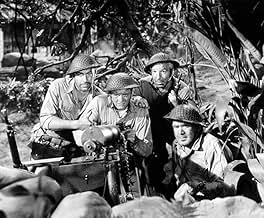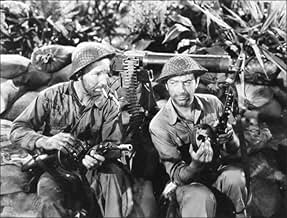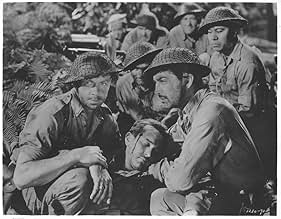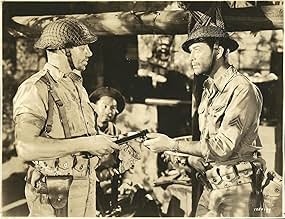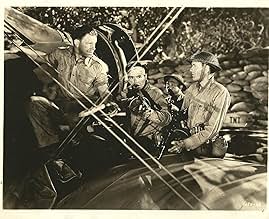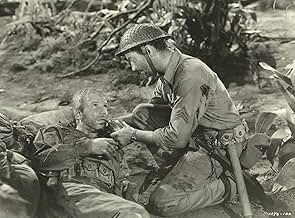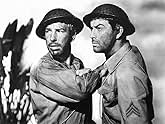IMDb RATING
6.9/10
2.9K
YOUR RATING
In 1942, in the Bataan peninsula of the Philippines, a ragtag American unit commanded by Sergeant Bill Dane attempts to blow-up a bridge in order to slow the Japanese advance.In 1942, in the Bataan peninsula of the Philippines, a ragtag American unit commanded by Sergeant Bill Dane attempts to blow-up a bridge in order to slow the Japanese advance.In 1942, in the Bataan peninsula of the Philippines, a ragtag American unit commanded by Sergeant Bill Dane attempts to blow-up a bridge in order to slow the Japanese advance.
- Director
- Writers
- Stars
- Awards
- 5 wins total
Alex Havier
- Yankee Salazar
- (as J. Alex Havier)
Ernie Alexander
- Wounded Soldier
- (uncredited)
Luke Chan
- Japanese Soldier
- (uncredited)
Wing Foo
- Japanese Soldier
- (uncredited)
Bud Geary
- Infantry Soldier
- (uncredited)
- Director
- Writers
- All cast & crew
- Production, box office & more at IMDbPro
Featured reviews
For a war movie, this was a bit unusual in that almost the whole film took part in one place. You could almost make a play out of this. A group of men stay in one area trying to sabotage a bridge so the Japanese can't use it to transport supplies. Meanwhile, they have to fend off attacks by the enemy. The closing scenes feature that attack and some are quite brutal.
At least half of the story is not action but melodramatic looks at the soldiers, particularly of the squad's sergeant leader Robert Taylor and one of his men who has an attitude problem: Lloyd Nolan. We also get some shorter profiles of combat men played by Robert Walker, Thomas Mitchell and Desi Arnez (yes, Lucy's husband).
The special effects are more than passable considering they weren't too advanced in the film industry compared to today's technology. However, credibility was a little thin as those Japanese soldiers died awfully fast in those combat scenes at the end. I swear I saw several of them drop over before anyone hit them!
Taylor was the best in this movie "army" and Walker was the annoying character, playing an extremely young and generally stupid Navy guy (don't ask) who never stopped talking in this irritating voice. Other than his character, this was a tough, no-nonsense war movie.
At least half of the story is not action but melodramatic looks at the soldiers, particularly of the squad's sergeant leader Robert Taylor and one of his men who has an attitude problem: Lloyd Nolan. We also get some shorter profiles of combat men played by Robert Walker, Thomas Mitchell and Desi Arnez (yes, Lucy's husband).
The special effects are more than passable considering they weren't too advanced in the film industry compared to today's technology. However, credibility was a little thin as those Japanese soldiers died awfully fast in those combat scenes at the end. I swear I saw several of them drop over before anyone hit them!
Taylor was the best in this movie "army" and Walker was the annoying character, playing an extremely young and generally stupid Navy guy (don't ask) who never stopped talking in this irritating voice. Other than his character, this was a tough, no-nonsense war movie.
World War II and it's the Bataan peninsula. 13 members of the US armed forces, with Filipino volunteers, have been hastily assembled to blow up a bridge and delay Japanese attempts to rebuild it for as long as possible. As the Japanese close in from the surrounding jungle, the men must also battle with their own wills to have any hope of survival.
Lets get the complaints of others out the way first. Yes this is a studio shot production, yes there is model work involved, and yes this is unashamedly a flag waving, chest thumping, rally call of heroism. Based around actual events, this is a fictionalised telling that also has no shame in being disparaging towards the Japanese in the film. Now are these things really a problem? This is after all 1943, a time when the US was struggling in the Pacific conflict. A loose copy of John Ford's 1934 film The Lost Patrol, Bataan served as a moral booster for the public back home. The message is clear, this may be tantamount to a suicide mission, because, well, war is indeed hell, but sacrifices are necessary to achieve the bigger freedom objective.
Nicely directed by Tay Garnett {The Postman Always Rings Twice} and tightly scripted by Robert Hardy Andrews {The Cross of Lorraine}, the film stars Robert Taylor, George Murphy, Thomas Mitchell, Robert Walker, Desi Arnaz & Lloyd Nolan. Violent and brutal for its time {the hand to hand bayonet sequences are brilliantly realised}, Bataan is also notable for portraying a racially integrated fighting force having to come together for the greater good. This group of men are a mixed bunch, different backgrounds, different races and different classes. But they are in the same boat as the Japanese start to pick them off one by one, and not only that, but Malaria is in the camp as well. The tension is racked up, the atmosphere stifling, we the viewers are witness to a unique show of heroism as we live with these men during their last soul sapping days.
The cast do really well when one considers they are in fact playing disposable characters. Taylor in particular is effective as the tough Sergeant forced into command of the group. While some scenes such as a moodily staged camouflaged Japanese approach are truly memorable and linger long in the memory. The end also is terrific, one which puts one in mind of Sam Peckinpah watching and nodding approvingly. High on suspense and beating a real brave heart, Bataan is up with the best that the war genre of film has to offer. Belyng its budget restrictions it achieves its aims and then some. 8.5/10
Lets get the complaints of others out the way first. Yes this is a studio shot production, yes there is model work involved, and yes this is unashamedly a flag waving, chest thumping, rally call of heroism. Based around actual events, this is a fictionalised telling that also has no shame in being disparaging towards the Japanese in the film. Now are these things really a problem? This is after all 1943, a time when the US was struggling in the Pacific conflict. A loose copy of John Ford's 1934 film The Lost Patrol, Bataan served as a moral booster for the public back home. The message is clear, this may be tantamount to a suicide mission, because, well, war is indeed hell, but sacrifices are necessary to achieve the bigger freedom objective.
Nicely directed by Tay Garnett {The Postman Always Rings Twice} and tightly scripted by Robert Hardy Andrews {The Cross of Lorraine}, the film stars Robert Taylor, George Murphy, Thomas Mitchell, Robert Walker, Desi Arnaz & Lloyd Nolan. Violent and brutal for its time {the hand to hand bayonet sequences are brilliantly realised}, Bataan is also notable for portraying a racially integrated fighting force having to come together for the greater good. This group of men are a mixed bunch, different backgrounds, different races and different classes. But they are in the same boat as the Japanese start to pick them off one by one, and not only that, but Malaria is in the camp as well. The tension is racked up, the atmosphere stifling, we the viewers are witness to a unique show of heroism as we live with these men during their last soul sapping days.
The cast do really well when one considers they are in fact playing disposable characters. Taylor in particular is effective as the tough Sergeant forced into command of the group. While some scenes such as a moodily staged camouflaged Japanese approach are truly memorable and linger long in the memory. The end also is terrific, one which puts one in mind of Sam Peckinpah watching and nodding approvingly. High on suspense and beating a real brave heart, Bataan is up with the best that the war genre of film has to offer. Belyng its budget restrictions it achieves its aims and then some. 8.5/10
Robert Taylor gives a gritty performance as the leader of a thrown together unit fighting a delaying action during the fall of the Philipines. Lloyd Nolan does a good job as a professional soldier with a past, Thomas Mitchell is good as the older career soldier, perhaps a bit out of shape from years of peace time duty. Robert Walkers portrayal of a young homesick sailor is a good start on his career. This 1943 movie features some of the best hand to hand combat scenes to come out of any war movie, regardless of era. The exhaustion afterwards is strikingly realistic. This movie, dialogue included, is patriotic. At the time of Bataan, there wasn't much good news as the US had suffered some devastating defeats. The characters, regardless of race or creed, are treated equally which is a real plus for that time. I first saw this movie in a theatre when I was 9, (and yes, after the movie was over, the house lights came on and the ushers passed thru the audience selling War Stamps). I liked the movie then, and like it even more now. I give it a 9.
NOTE: A previous persons comment stated that they were not even wearing American helmets. In fact, the helmets worn in the movie ARE correct for the American Army in the early 1940's.
NOTE: A previous persons comment stated that they were not even wearing American helmets. In fact, the helmets worn in the movie ARE correct for the American Army in the early 1940's.
My Mom saw this movie at the time it was released and said it gave her more nightmares than any horror film she ever saw. It is still violent today and must have been shockingly brutal back in the day.
Yes, you can say some of the soldiers are clichéd, but death is shown unflinchingly. Combat is portrayed as a bloody, messy, fatigue-inducing business. Boredom and endless waiting take their toll on nerves as well. The banter and cocky talk is whistling past the graveyard.
Lloyd Nolan's character is rough and unlikeable. He fights for freedom, but he fights dirty and he doesn't pretty things up with patriotic speeches. Some might complain about the black soldier playing harmonica and taking orders from white men. Actually, for the time, he was portrayed with dignity and shown to be as brave as any of the other soldiers. As for Robert Taylor, his weariness and resolve at the end are stirring and the last scene is not one you will soon forget.
Ignoring the propaganda aspects of the movie, the last half works as almost a pure horror movie, as our cast gets gruesomely picked off by unseen foes lurking in the jungle.
Exciting and gripping, it's easy to overlook the faults of this most violent and gritty of WW2 films made at the time.
"Bushido, Bushwa! You stink!" So died the heroes of Bataan...
Yes, you can say some of the soldiers are clichéd, but death is shown unflinchingly. Combat is portrayed as a bloody, messy, fatigue-inducing business. Boredom and endless waiting take their toll on nerves as well. The banter and cocky talk is whistling past the graveyard.
Lloyd Nolan's character is rough and unlikeable. He fights for freedom, but he fights dirty and he doesn't pretty things up with patriotic speeches. Some might complain about the black soldier playing harmonica and taking orders from white men. Actually, for the time, he was portrayed with dignity and shown to be as brave as any of the other soldiers. As for Robert Taylor, his weariness and resolve at the end are stirring and the last scene is not one you will soon forget.
Ignoring the propaganda aspects of the movie, the last half works as almost a pure horror movie, as our cast gets gruesomely picked off by unseen foes lurking in the jungle.
Exciting and gripping, it's easy to overlook the faults of this most violent and gritty of WW2 films made at the time.
"Bushido, Bushwa! You stink!" So died the heroes of Bataan...
1943 audiences already knew how Bataan would end before they went to see the film, but they went anyway, since this Tay Garnett-directed combat picture is a rugged tribute to the 'expendable' men of the Philippines of 1942. I can't do better than James Agee's fine review when the movie came out, but would like to add a few things of my own.
Rather than try to show the entire evacuation and abandonment of the Phillipines, which would be perhaps overwhelmingly depressing, the film-makers decided to focus on one small, fictional incident that could, in effect, stand in for everything else. They chose wisely. What happens is that we watch a group of soldiers defend and then destroy a bridge, so as to slow down the Japanese army's advance, if only by a few hours, to buy precious time for everyone else. None of these men wants to be a hero. They're all stuck there, and would rather be someplace else. While some are more aggressive than others, no one is wholly brave; and though there is a good deal of nervousness and occasional cowardice, they all pull together admirably in the end.
Though filmed on the Culver City lot, the film cleverly and expressionistic ally suggests a tropical environment. As the story progresses the jungle gets foggier. It was never too inviting to begin with; by the movie's end it is absolutely forbidding.
The acting is variable. Some of the casting is peculiar. Thomas Mitchell plays a corporal named Feingold, but can't seem to get rid of the slight, American-style brogue that was so much a part of his screen persona. Desi Arnaz has a small role. There is a fairly straightforward presentation of a black man whose color is the least important thing about him. Robert Walker, in what I believe is his first film, has a showy role as a garrulous, yarn-spinning sailor. His character is, I imagine, supposed to be a typically charming, bumptious All-American boy, along the lines, perhaps, of Van Johnson. I find Walker,--who was an excellent actor--obnoxious in the part. Lloyd Nolan is tough as nails as a hard-case soldier with a dark past.
The movie's biggest asset in the acting department also happens to be its star: Robert Taylor. This pretty boy matinée idol gives a fine performance as the sergeant with a job no man in his right mind would want. And he is in his right mind. Taylor has no vanity in the part. He is as dirty and unshaven as everyone else in the cast, and at times shows flashes of depth and insight that are startling given his lightweight reputation. Taylor pulls the film together, with no Duke Wayne ostentation or posturing, and proves, like the film, to be stronger and truer to life than we might at first have imagined.
Rather than try to show the entire evacuation and abandonment of the Phillipines, which would be perhaps overwhelmingly depressing, the film-makers decided to focus on one small, fictional incident that could, in effect, stand in for everything else. They chose wisely. What happens is that we watch a group of soldiers defend and then destroy a bridge, so as to slow down the Japanese army's advance, if only by a few hours, to buy precious time for everyone else. None of these men wants to be a hero. They're all stuck there, and would rather be someplace else. While some are more aggressive than others, no one is wholly brave; and though there is a good deal of nervousness and occasional cowardice, they all pull together admirably in the end.
Though filmed on the Culver City lot, the film cleverly and expressionistic ally suggests a tropical environment. As the story progresses the jungle gets foggier. It was never too inviting to begin with; by the movie's end it is absolutely forbidding.
The acting is variable. Some of the casting is peculiar. Thomas Mitchell plays a corporal named Feingold, but can't seem to get rid of the slight, American-style brogue that was so much a part of his screen persona. Desi Arnaz has a small role. There is a fairly straightforward presentation of a black man whose color is the least important thing about him. Robert Walker, in what I believe is his first film, has a showy role as a garrulous, yarn-spinning sailor. His character is, I imagine, supposed to be a typically charming, bumptious All-American boy, along the lines, perhaps, of Van Johnson. I find Walker,--who was an excellent actor--obnoxious in the part. Lloyd Nolan is tough as nails as a hard-case soldier with a dark past.
The movie's biggest asset in the acting department also happens to be its star: Robert Taylor. This pretty boy matinée idol gives a fine performance as the sergeant with a job no man in his right mind would want. And he is in his right mind. Taylor has no vanity in the part. He is as dirty and unshaven as everyone else in the cast, and at times shows flashes of depth and insight that are startling given his lightweight reputation. Taylor pulls the film together, with no Duke Wayne ostentation or posturing, and proves, like the film, to be stronger and truer to life than we might at first have imagined.
Did you know
- TriviaPrologue: "When Japan struck, our desperate need was time--time to Marshall our new armies. Ninety-six priceless days were bought for us--with their lives--by the defenders of Bataan, the Philippine army which formed the bulk of MacArthur's infantry fighting shoulder to shoulder with Americans. To those immortal dead, who heroically stayed stayed the wave of barbaric conquest, this picture is reverently dedicated."
- GoofsAlthough the American soldier was clearly a great coconut tree climber, it is near to impossible to sit atop a coconut tree. Many Filipinos to this day fall when attempting this.
- Quotes
Sergeant Bill Dane: Come on, suckers! What's the matter with you? What are you waitin' for? Didn't think we were here, did you? You dirty rotten rats! We're still here! We'll always be here! Why don't you come and get it?
- Crazy creditsClosing credits epilogue: So fought the heroes of Bataan. Their sacrifice made possible our victories in the Coral and Bismark Seas, at Midway, on New Guinea and Guadalcanal. Their spirit will lead us back to Bataan!
- Alternate versionsAlso available in a computer colorized version.
- ConnectionsFeatured in Toast of the Town: A Salute to Lucy and Desi (1954)
- SoundtracksSt. Louis Blues
(1914) (uncredited)
Music and Lyrics by W.C. Handy
Sung a cappella and hummed often by Kenneth Spencer
- How long is Bataan?Powered by Alexa
Details
Box office
- Budget
- $958,000 (estimated)
- Runtime1 hour 54 minutes
- Color
- Aspect ratio
- 1.37 : 1
Contribute to this page
Suggest an edit or add missing content



